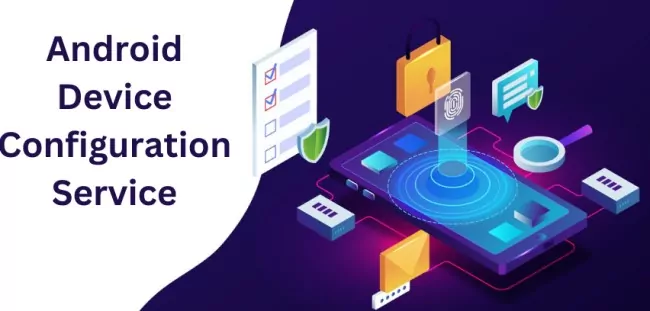Android Device Configuration Service: What is Collected?
The Android operating system has revolutionized the mobile device landscape, providing users with a powerful and customizable platform. To optimize the user experience and ensure compatibility across a wide range of devices, Google has implemented the Android Device Configuration Service. This service collects essential data from Android devices to understand users' needs better and improve the overall performance of the Android ecosystem.
In this article, we will explore the Android Device Configuration Service, understand its purpose, and delve into the data it collects to enhance users' Android experience.

1 What is the Android Device Configuration Service?
The Android Device Configuration Service is an integral part of the Android operating system that collects important information about a user's device configuration.
It allows Google to gather insights into various hardware and software aspects, such as device models, manufacturers, CPU and GPU details, screen size and resolution, Android version, and more. By analyzing this data, Google can optimize device performance, provide tailored recommendations, and deliver updates that cater to specific hardware configurations.

Source: www.blog.google
2 Data Collected by Android Device Configuration Service
The Android Device Configuration Service mainly collects non-personally identifiable information. This data is crucial to help optimize device performance and improve the overall Android ecosystem. Let's explore some key collected data collected below:
| Device & Account Identifiers | In device and account identifiers, the device model and manufacturer information are collected to help Google understand the differences when it comes to compatibility testing, software updates, and optimizations for specific hardware configurations. To provide ongoing performance optimization, resource allocation, and power management, CPU and GPU details are also gathered. Screen size and resolution data, on the other hand, assist in creating better user interfaces, optimizing app layouts, and ensuring compatibility with various screen sizes. |
| Software & Security Software Versions | Software and security software versions are essential for Google to identify common bugs, compatibility issues, and security vulnerabilities. This calls for more efficient updates, bug fixing, and overall system stability. The Android Device Configuration Service also gathers data on installed applications. This is to help Google analyze trends, improve compatibility with popular applications, and recognize potential issues caused by specific apps. |
| Localization & Language Settings | With the localization and language settings data, Google will be able to provide recommended translations, language-oriented updates, and other relevant content based on the user’s preferred language and region. It enhances the user experience by delivering personalized content and information. |
| Battery & Power Usage | Google uses the battery and power usage data to understand some common power-draining factors, improve device performance, and optimize battery consumption. This can further help Google develop strategies on how to prolong battery life and increase user satisfaction. |
| Network Connectivity & Performance Data | Google keeps tabs on all the activities used within apps, devices, and browsers while searching and browsing the internet. Be it watching a video, conducting a search, interacting with ads or content, and making a purchase, Google collects and stores that information for further performance optimization references. |
3 How Does Google Utilize the Collected Data?
Google uses this data to conduct the following tasks:
- Ensure that your device receives timely software updates and security patches.
- Ensure that apps and services are functioning properly across various Android devices with specifications and software.
- Protect your device and the Android ecosystem from potential fraud, abuse, and other harmful behavior. For example, Google uses an identifier to detect abnormal login behavior.
- Maintain aggregate metrics about Android devices: For example, Google uses anonymized data about how devices connect to mobile networks to optimize the trade off between maintaining connectivity and preserving battery life.
Protection of User Privacy
- While the Android Device Configuration Service collects data, Google takes extensive measures to prioritize user privacy and data protection. All data collected is anonymized and aggregated, ensuring that it cannot be traced back to individual users. Personally identifiable information is not collected or shared without explicit user consent.
- Google strictly adheres to privacy regulations and guidelines, ensuring that all data collection practices associated with the Android Device Configuration Service comply with applicable laws, policies, and user expectations. User privacy and data security are fundamental considerations throughout the entire process.

4 How Android Device Configuration Service Works
Now that we understand the definition of Android Device Configuration Service, let’s take a closer look at how it actually works!
Android Device Configuration Service sends data from Android devices to Google periodically.This data helps Google determine whether your device is up-to-date or not. Note that Android devices don’t stay connected to Android Device Configuration Service 24/7. Instead they are connected every few days, and the latest data collected will override the previous data.
With the data collected, Google can help ensure:
- Whether you devices need an update
- Apps, softwares and other services work coherently across different Android devices
- Your Android devices are free of cyberattacks such as fraud, malware, and virus
As the Android Device Configuration Service follows Google’s Privacy Policy, you can’t delete the data when your device is in use. The data will only be deleted when you log out of your Google account or when you completely delete all of the data on your Android devices.
6 Troubleshooting Common Issues with Android Device Configuration Service
We all know that technology gadgets malfunction from time to time. In this section, we gather some of the common troubleshooting tips for you when dealing with unresponsive Android devices.
- Restart your Android phone
- Update your app or software to the latest version
- Clear the cache and data on your app
- Free up some storage space on your device
- Check your network connections
- Perform factory reset
- Disable or modify battery optimization settings
- Remove unused widgets or wallpapers
- Uninstall problematic apps
- Disable unnecessary animations
While technical glitches are unavoidable, it’s always recommended to regularly maintain your devices and run for diagnostics to prevent unexpected issues that may later on cause more damage to the organization’s operation.
7 How to Configure Access for Device Settings and Apps on Android
Using a mobile device management solution will make mobile phone configuration easy and has multiple features to secure data; for example,
- Block camera, lockscreen camera, screenshot, microphone, factory reset, safe mode, developer mode, and network sharing.
- Keep disable/enable Wi-Fi, Bluetooth, and GPS status.
- Disable USB file transfer, and USB external device connection.
- Create app blocklist or allowlist.
- Configure app permission settings including grant/deny location, phone, camera, storage, clandar, contacts, etc.
- Forced encryption of stored data on device.
- Customize compliance settings
Here’s a step by step guide on how to configure your Android devices with MDM.
- Step 1.
- Log into AirDroid Business admin console. You can apply for 14-day free trial here.
- Step 2.
- Once log in, navigate to “Device Enrollment” and begin your device enrollment process. This step is to authorize permissions for device being managed.
- There are various enrollment methods to meet different device types, such as regular enrollment, Android Enterprise, USB, and Zero-touch.
- Learn more: How do I choose the enrollment method on AirDroid Business?
- Step 3.
- As you complete the enrollment, the app for controlled end device will be installed.
- Now you can start configuring device settings in the admin console. You can go to "Policy & Kiosk" and "Apps" to set up the Android devices.
Conclusion
The Android Device Configuration Service plays a critical role in enhancing the Android user experience. It helps collect non-personally identifiable data about device configurations. This data enables Google to optimize resource allocation, provide tailored updates, and improve overall device performance. By understanding what the Android Device Configuration Service collects, users can better appreciate the improvements it brings to the Android ecosystem while being reassured that their privacy and personal information remain protected. As Google continues to prioritize user privacy and data security, the Android Device Configuration Service will continue to evolve, delivering a seamless and personalized Android experience to millions of users worldwide.
AirDroid Business now allows you to experience a powerful MDM solution integrated with Google Android Enterprise. Get started for free today!







Leave a Reply.